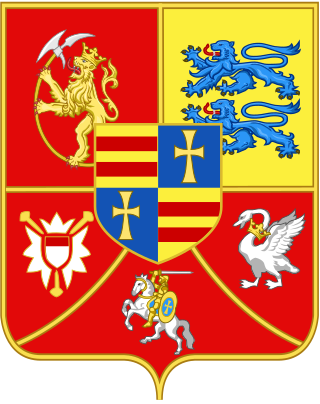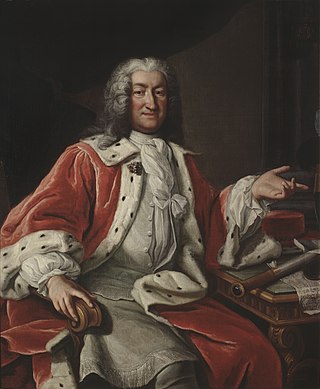| Years in Sweden: | 1740 1741 1742 1743 1744 1745 1746 |
| Centuries: | 17th century · 18th century · 19th century |
| Decades: | 1710s 1720s 1730s 1740s 1750s 1760s 1770s |
| Years: | 1740 1741 1742 1743 1744 1745 1746 |


Events from the year 1743 in Sweden
| Years in Sweden: | 1740 1741 1742 1743 1744 1745 1746 |
| Centuries: | 17th century · 18th century · 19th century |
| Decades: | 1710s 1720s 1730s 1740s 1750s 1760s 1770s |
| Years: | 1740 1741 1742 1743 1744 1745 1746 |


Events from the year 1743 in Sweden

Adolf Frederick, or Adolph Frederick was King of Sweden from 1751 until his death in 1771. He was the son of Christian August of Holstein-Gottorp, Prince of Eutin, and Albertina Frederica of Baden-Durlach. He was an uncle of Catherine the Great and husband to Louisa Ulrika of Prussia.

Frederick I was King of Sweden from 1720 until his death, having been prince consort of Sweden from 1718 to 1720, and was also Landgrave of Hesse-Kassel from 1730. He ascended the throne following the death of his brother-in-law absolutist Charles XII in the Great Northern War, and the abdication of his wife, Charles's sister and successor Ulrika Eleonora, after she had to relinquish most powers to the Riksdag of the Estates and thus chose to abdicate. His powerless reign and lack of legitimate heirs of his own saw his family's elimination from the line of succession after the parliamentary government dominated by pro-revanchist Hat Party politicians ventured into a war with Russia, which ended in defeat and the Russian tsarina Elizabeth getting Adolf Frederick of Holstein-Gottorp instated following the death of the king. Whilst being the only Swedish monarch called Frederick, he was Frederick I of Hesse-Kassel and thus Frederick I also of Sweden, though other Swedish monarchs with non-repeating names have not been given numerals.

Ulrika Eleonora or Ulrica Eleanor, known as Ulrika Eleonora the Younger, was Queen of Sweden, reigning in her own right from 5 December 1718 until her abdication on 29 February 1720 in favour of her husband King Frederick, and then as his consort until her death.

The monarchy of Sweden is centered on the monarchical head of state of Sweden, by law a constitutional and hereditary monarchy and with a parliamentary system. There have been kings in what now is the Kingdom of Sweden for more than a millennium. Originally an elective monarchy, it became a hereditary monarchy in the 16th century during the reign of Gustav Vasa, though virtually all monarchs before that belonged to a limited and small number of families which are considered to be the royal dynasties of Sweden.

Frederick I was King of Denmark and Norway. He was the last Roman Catholic monarch to reign over Denmark and Norway, when subsequent monarchs embraced Lutheranism after the Protestant Reformation. As king of Norway, Frederick is most remarkable in never having visited the country and was never crowned as such. Therefore, he was styled King of Denmark, the Vends and the Goths, elected King of Norway. Frederick's reign began the enduring tradition of calling kings of Denmark alternatively by the names Christian and Frederick, which has continued up to the reign of the current monarch, Margrethe II.

Holstein-Gottorp or Schleswig-Holstein-Gottorp is the historiographical name, as well as contemporary shorthand name, for the parts of the duchies of Schleswig and Holstein, also known as Ducal Holstein, that were ruled by the dukes of Schleswig-Holstein-Gottorp, a side branch of the elder Danish line of the House of Oldenburg. Other parts of the duchies were ruled by the kings of Denmark.

The House of Oldenburg is a German dynasty with links to Denmark since the 15th century. It has had branches that rule or have ruled in Denmark, Iceland, Greece, Norway, Russia, Sweden, the United Kingdom, Schleswig, Holstein, and Oldenburg. The current Queen of Denmark, King of Norway and King of the United Kingdom are all patrilineal descendants of the Glücksburg branch of this house.

Hedvig Sophia Augusta of Sweden, Duchess of Holstein-Gottorp, was the eldest child of Charles XI of Sweden and Ulrike Eleonore of Denmark. She was heir presumptive to the Swedish throne from her birth until that of her brother one year later and again from the start of his reign as King of Sweden, in 1697, until her death and the regent of the duchy of Holstein-Gottorp for her minor son from 1702 to 1708. Some sources refer to her as Sofia.

The Treaty of Åbo or the Treaty of Turku was a peace treaty signed between the Russian Empire and Sweden in Åbo on 18 August [O.S. 7 August] 1743 in the end of the Russo-Swedish War of 1741–1743.

Charles Frederick, Duke of Schleswig-Holstein-Gottorp was a Prince of Sweden and Duke of Schleswig-Holstein-Gottorp and an important member of European royalty. His dynasty, the Dukes of Schleswig-Holstein-Gottorp, were a cadet branch of the ancient House of Oldenburg, which at that time was ruling Denmark-Norway. His mother was a sister of Charles XII of Sweden. Charles Frederick married a daughter of Peter the Great and became the father of the future Peter III of Russia. As such, he is the progenitor of the Russian imperial house of Holstein-Gottorp-Romanov and the patrilineal ancestor of all Russian emperors starting with Peter III, except for Catherine II.

Christian August of Holstein-Gottorp-Eutin was a cadet of the reigning ducal House of Holstein-Gottorp who became prince of Eutin, prince-bishop of Lübeck and regent of the Duchy of Holstein-Gottorp.

The attempt to create a Kingdom of Finland in 1742 is a little-known chapter in the history of Finland. After the Russian occupation during the Russo-Swedish War (1741–1743) and vague promises of making Finland independent, Finns elected the Duke Peter of Holstein-Gottorp, who later became heir to the throne of Russia and Emperor as Peter III, as the King of Finland. However, the political situation had outgrown the idea of Finnish independence, which quickly evaporated.
The Dalecarlian rebellion of 1743, also known as the Fourth Dalecarlian rebellion and stora daldansen was a rebellion that broke out in the Swedish province of Dalarna in 1743. Its cause was the peasants' dissatisfaction with the "lords' government" of the Age of Liberty. This dissatisfaction was strongest in Dalarna, partly because the Hats had introduced restrictions in the Dalecarlians' free exchange of goods with neighboring Norway, but mainly because of the unlucky Russo-Swedish War (1741–43) to which the peasants had to provide soldiers. It was the last major uprising in Sweden to have started in rural areas.

Henrik Magnus von Buddenbrock was a Swedish baron and Lieutenant General. He and Carl Emil Lewenhaupt were executed for negligence in the Russo-Swedish War, in the aftermath of the defeat at Villmanstrand.

Prince Frederik of Hesse, Landgrave Friedrich of Hesse-Cassel was a Danish-German nobleman, field marshal and governor-general of Norway (1810–1813) and the same in the duchies of Schleswig and Holstein (1836–1842).

Louise of Denmark and Norway was a Danish and Norwegian princess, the daughter of King Christian VI of Denmark and his wife Sophie Magdalene of Brandenburg-Kulmbach. Following her marriage to Ernest Frederick III, Duke of Saxe-Hildburghausen, she became Duchess of Saxe-Hildburghausen.

Princess Margravine Albertina Frederica of Baden-Durlach was a German princess. She was the daughter of Frederick VII, Margrave of Baden-Durlach and his wife Duchess Augusta Marie of Holstein-Gottorp. She married Christian August of Holstein-Gottorp, Prince of Eutin.

Events from the year 1723 in Sweden.

Events from the year 1742 in Sweden
The Holstein Party, was the name of a political group in 18th-century Sweden which played a significant role in politics after the death of Charles XII of Sweden in 1718 and until 1727.